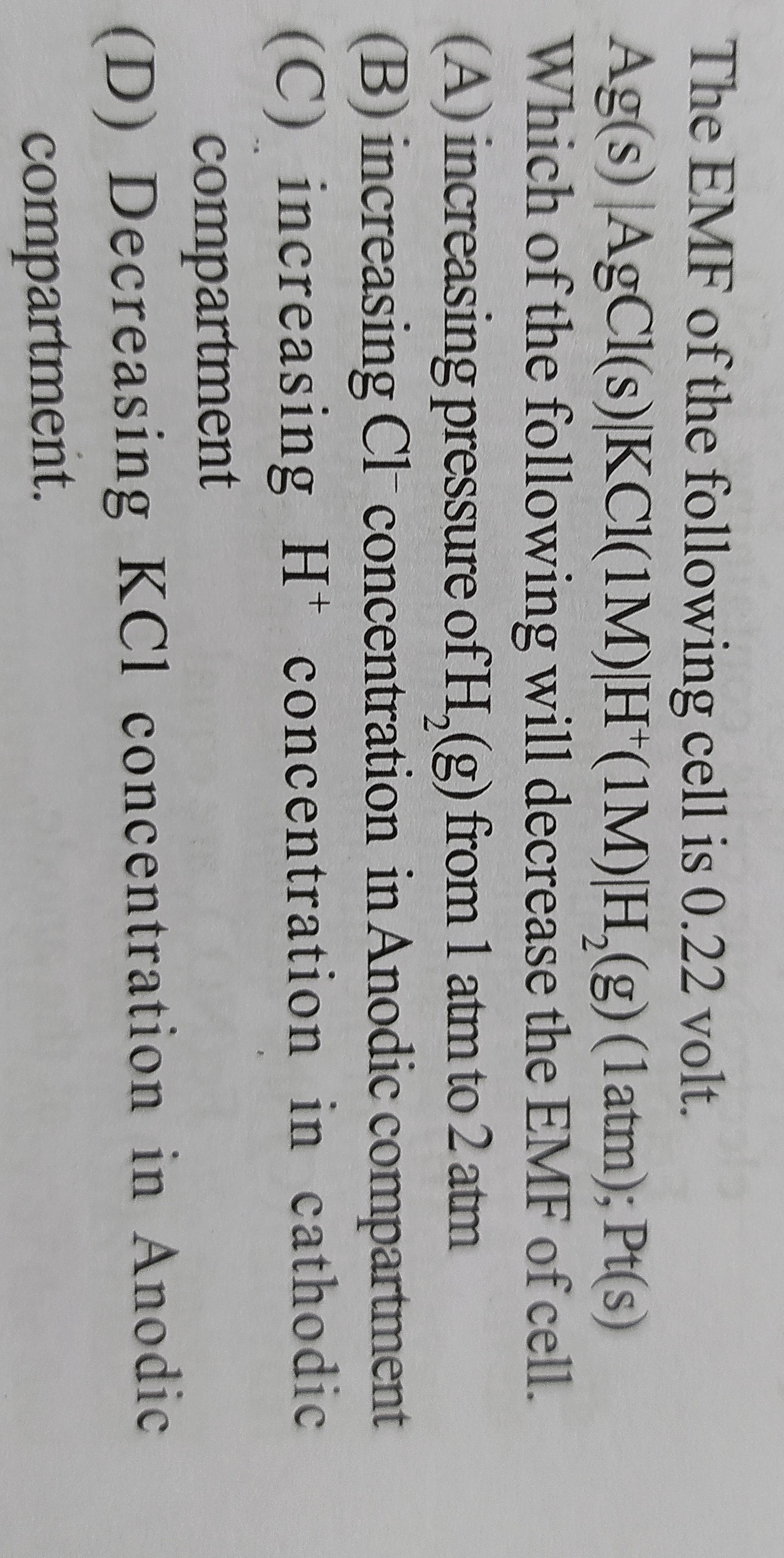Question
Question: The EMF of the following cell is 0.22 volt. Ag(s)|AgCl(s)|KCl(1M)|H+(1M)|H₂(g) (1atm); Pt(s) Which...
The EMF of the following cell is 0.22 volt.
Ag(s)|AgCl(s)|KCl(1M)|H+(1M)|H₂(g) (1atm); Pt(s)
Which of the following will decrease the EMF of cell.

increasing pressure of H₂(g) from 1 atm to 2 atm
increasing Cl⁻ concentration in Anodic compartment
increasing H⁺ concentration in cathodic compartment
Decreasing KCl concentration in Anodic compartment.
Increasing pressure of H₂(g) from 1 atm to 2 atm OR Decreasing KCl concentration in Anodic compartment.
Solution
The given electrochemical cell is:
Ag(s)|AgCl(s)|KCl(1M)|H+(1M)|H₂(g) (1atm); Pt(s)
According to the IUPAC convention for cell notation, the anode (oxidation half-cell) is written on the left, and the cathode (reduction half-cell) is written on the right.
-
Anode (Oxidation): Ag electrode in contact with AgCl and Cl⁻ ions. Ag(s) + Cl⁻(aq) → AgCl(s) + e⁻
-
Cathode (Reduction): Standard Hydrogen Electrode (SHE). 2H⁺(aq) + 2e⁻ → H₂(g)
To get the overall cell reaction, we balance the electrons by multiplying the anode reaction by 2:
2Ag(s) + 2Cl⁻(aq) → 2AgCl(s) + 2e⁻ 2H⁺(aq) + 2e⁻ → H₂(g)
Overall Cell Reaction:
2Ag(s) + 2Cl⁻(aq) + 2H⁺(aq) → 2AgCl(s) + H₂(g)
Now, let's write the Nernst equation for this reaction. The number of electrons transferred (n) is 2. The reaction quotient Q is given by:
Q=[Ag(s)]2⋅[Cl−(aq)]2⋅[H+(aq)]2[AgCl(s)]2⋅PH2(g)
Since Ag(s) and AgCl(s) are solids, their activities are considered as 1.
So, Q=[Cl−(aq)]2⋅[H+(aq)]2PH2(g)
The Nernst equation is:
Ecell=Ecell∘−nFRTlnQ Ecell=Ecell∘−2FRTln([Cl−(aq)]2⋅[H+(aq)]2PH2(g))
Now let's analyze how changes in each option affect Ecell:
(A) increasing pressure of H₂(g) from 1 atm to 2 atm
If PH2(g) increases, Q (which has PH2(g) in the numerator) increases. According to the Nernst equation, an increase in Q makes the term 2FRTlnQ more positive. Since this term is subtracted from Ecell∘, the overall Ecell will decrease.
(B) increasing Cl⁻ concentration in Anodic compartment
If [Cl−(aq)] increases, Q (which has [Cl−(aq)] in the denominator) decreases. A decrease in Q makes the term 2FRTlnQ less positive (or more negative). Since this term is subtracted from Ecell∘, the overall Ecell will increase.
(C) increasing H⁺ concentration in cathodic compartment
If [H+(aq)] increases, Q (which has [H+(aq)] in the denominator) decreases. A decrease in Q makes the term 2FRTlnQ less positive (or more negative). Since this term is subtracted from Ecell∘, the overall Ecell will increase.
(D) Decreasing KCl concentration in Anodic compartment.
KCl provides Cl⁻ ions. Decreasing KCl concentration means decreasing [Cl−(aq)]. If [Cl−(aq)] decreases, Q (which has [Cl−(aq)] in the denominator) increases. An increase in Q makes the term 2FRTlnQ more positive. Since this term is subtracted from Ecell∘, the overall Ecell will decrease.
Both options (A) and (D) lead to a decrease in the EMF of the cell.
